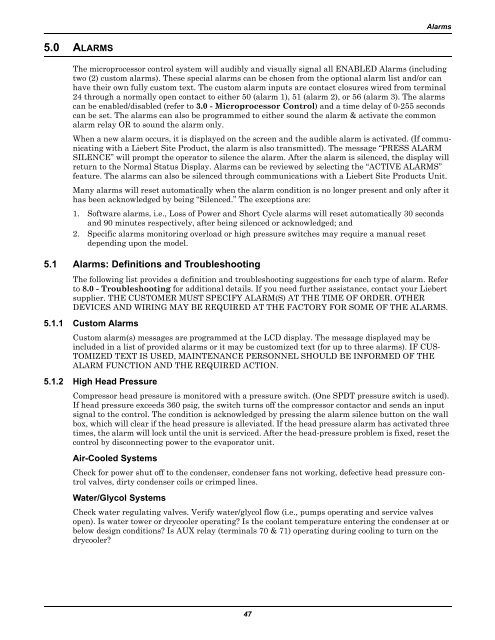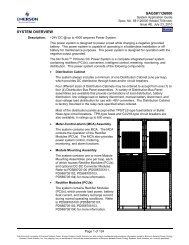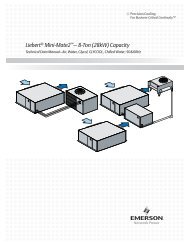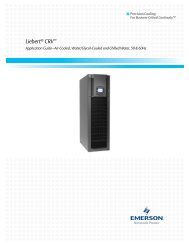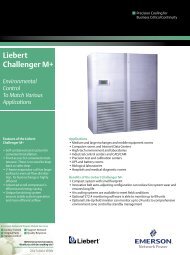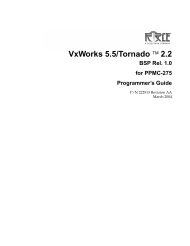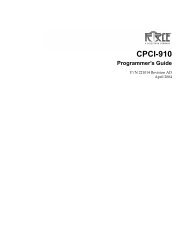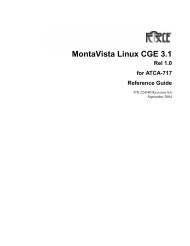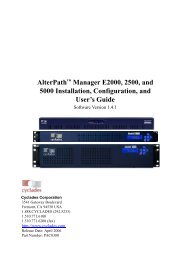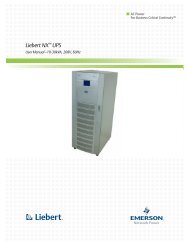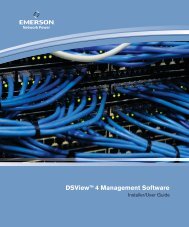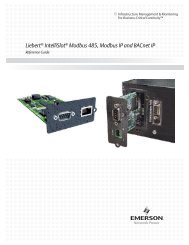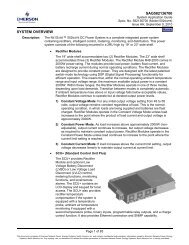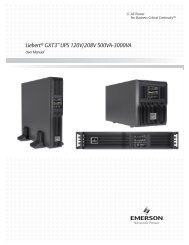Liebert Mini-Mate2, 8 Ton - Emerson Network Power
Liebert Mini-Mate2, 8 Ton - Emerson Network Power
Liebert Mini-Mate2, 8 Ton - Emerson Network Power
You also want an ePaper? Increase the reach of your titles
YUMPU automatically turns print PDFs into web optimized ePapers that Google loves.
5.0 ALARMS<br />
47<br />
Alarms<br />
The microprocessor control system will audibly and visually signal all ENABLED Alarms (including<br />
two (2) custom alarms). These special alarms can be chosen from the optional alarm list and/or can<br />
have their own fully custom text. The custom alarm inputs are contact closures wired from terminal<br />
24 through a normally open contact to either 50 (alarm 1), 51 (alarm 2), or 56 (alarm 3). The alarms<br />
can be enabled/disabled (refer to 3.0 - Microprocessor Control) and a time delay of 0-255 seconds<br />
can be set. The alarms can also be programmed to either sound the alarm & activate the common<br />
alarm relay OR to sound the alarm only.<br />
When a new alarm occurs, it is displayed on the screen and the audible alarm is activated. (If communicating<br />
with a <strong>Liebert</strong> Site Product, the alarm is also transmitted). The message “PRESS ALARM<br />
SILENCE” will prompt the operator to silence the alarm. After the alarm is silenced, the display will<br />
return to the Normal Status Display. Alarms can be reviewed by selecting the “ACTIVE ALARMS”<br />
feature. The alarms can also be silenced through communications with a <strong>Liebert</strong> Site Products Unit.<br />
Many alarms will reset automatically when the alarm condition is no longer present and only after it<br />
has been acknowledged by being “Silenced.” The exceptions are:<br />
1. Software alarms, i.e., Loss of <strong>Power</strong> and Short Cycle alarms will reset automatically 30 seconds<br />
and 90 minutes respectively, after being silenced or acknowledged; and<br />
2. Specific alarms monitoring overload or high pressure switches may require a manual reset<br />
depending upon the model.<br />
5.1 Alarms: Definitions and Troubleshooting<br />
The following list provides a definition and troubleshooting suggestions for each type of alarm. Refer<br />
to 8.0 - Troubleshooting for additional details. If you need further assistance, contact your <strong>Liebert</strong><br />
supplier. THE CUSTOMER MUST SPECIFY ALARM(S) AT THE TIME OF ORDER. OTHER<br />
DEVICES AND WIRING MAY BE REQUIRED AT THE FACTORY FOR SOME OF THE ALARMS.<br />
5.1.1 Custom Alarms<br />
Custom alarm(s) messages are programmed at the LCD display. The message displayed may be<br />
included in a list of provided alarms or it may be customized text (for up to three alarms). IF CUS-<br />
TOMIZED TEXT IS USED, MAINTENANCE PERSONNEL SHOULD BE INFORMED OF THE<br />
ALARM FUNCTION AND THE REQUIRED ACTION.<br />
5.1.2 High Head Pressure<br />
Compressor head pressure is monitored with a pressure switch. (One SPDT pressure switch is used).<br />
If head pressure exceeds 360 psig, the switch turns off the compressor contactor and sends an input<br />
signal to the control. The condition is acknowledged by pressing the alarm silence button on the wall<br />
box, which will clear if the head pressure is alleviated. If the head pressure alarm has activated three<br />
times, the alarm will lock until the unit is serviced. After the head-pressure problem is fixed, reset the<br />
control by disconnecting power to the evaporator unit.<br />
Air-Cooled Systems<br />
Check for power shut off to the condenser, condenser fans not working, defective head pressure control<br />
valves, dirty condenser coils or crimped lines.<br />
Water/Glycol Systems<br />
Check water regulating valves. Verify water/glycol flow (i.e., pumps operating and service valves<br />
open). Is water tower or drycooler operating? Is the coolant temperature entering the condenser at or<br />
below design conditions? Is AUX relay (terminals 70 & 71) operating during cooling to turn on the<br />
drycooler?


